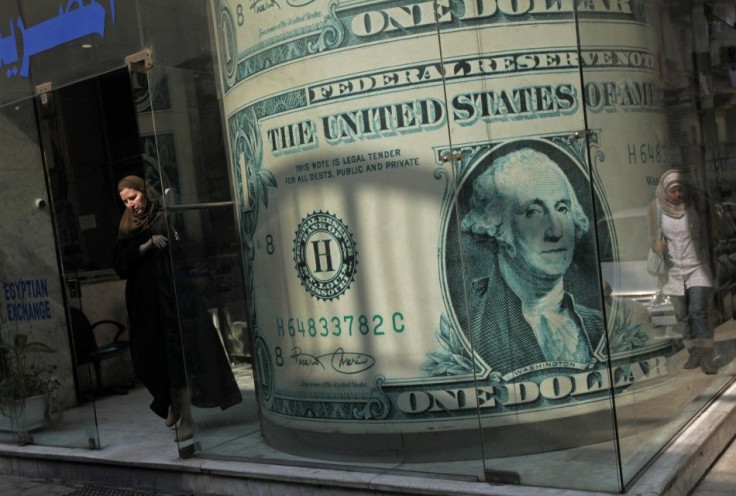U.S. Dollar: Investors Complain About - But Still Hold - the Buck
Analysis

These days, everyone in commerce and finance circles seems to complain about the dollar, but few institutional investors want to part with them.
Despite unprecedented quantitative easing by the U.S Federal Reserve, and $1 trillion-level U.S. budget deficits, the dollar continues to hold its own against a basket of the world's other, major currencies.
The U.S. Dollar Index, which tracks the greenback against a basket of currencies, was at 81.54 on Friday at mid-day, up 0.71 percent. That's higher than the low at/near 72.50 registered in the spring 2011.
To be sure, the dollar index is still down 9 percent since hitting a high at/near 90 as the financial crisis' worsened in the second half of 2008, but the decline is far from the dollar collapse some had forecast as a result of the flood of stimulus dollars hitting global markets.
Why Hasn't Dollar Collapsed?
Why hasn't the dollar collapsed? Several reasons.
First, the flood of dollars added to the market has been offset by dollar-denominated wealth destruction that occurred in the U.S. stock market and housing markets. In other words, while there are more dollars circulating in global financial markets, the full effect of fiscal stimulus has been muted.
Second, the dollar remains the world's primary reserve currency. Up until the European government debt crisis, the euro had served as an alternate dollar, but that role may prove to be a short period in foreign exchange history, if Europe does not inconvertibly convince institutional investors that it has a viable plan to both stabilize the finances of Italy, and that also protects the value of the euro over time.
Morevover, as the above suggests, achieving that will be a bit of a trick for European Union policy makers: if they don't provide an adequate bailout for debt-laden countries, the eurozone risks a default and/or contagion -- another wave of the financial crisis. However, if eurozone leaders provide a bailout that's too large and/or that otherwise scares bond holders, they risk increasing inflation, weakening the euro, or losing the confidence of investors.
Further, although initial evidence suggests Italy has made strides to get its finances on a balance-budget trajectory -- Italy sold €4.75 billion in three-year notes at an average rate of 4.83 percent on Friday -- investors remain concerned about credit agency downgrades of Italy and other debt-plagued Europe countries.
All of the aforementioned problems facing the eurozone have prompted institutional investors to take a more-cautious stance toward the euro as a reserve currency. Investors still want to diversify in to euros, but as of the now, the euro is not going to displace the dollar as the world's primary reserve currency.
Third, the United States, despite its large budget deficit, trade deficit, inadequate GDP-growth economic recovery, and the seemingly continual partisan fight between Democrats and Republicans in Washington, still boasts an economy that, in many ways, remains the envy of the world.
Historically, the U.S.'s economic system has proven to be remarkably flexible and resilient -- able to withstand losses of whole sectors and, via ingenuity and new technologies, create new engines of both GP growth and job growth. That said, economists caution that no two recovery cycles are identical and this cycle -- the globalization era with its lower cost structure -- will likely present the toughest hurdle for the nation's job creation machine since the Great Depression of the 1930s.
In other words, there are still several unknowns regarding the structure of the U.S. economy in the globalization era's second decade; even so, institutional investors still view the U.S. as a promising place to deploy capital. That attractiveness boosts the value of dollar-denominated assets, and that obviously supports the dollar's value.
Dollar Poised to Rally in 2012?
The dollar in the initial 12 years of the 21st century has taken it on the chin -- it's been its toughest period since the stagflation period of the mid/late 1970s. Further, until policy makers can find ways to increase U.S. GDP growth to at least 3 percent per year, the dollar will likely struggle to gain short-term versus the pound, yen, Swiss franc, Canadian dollar and Australian dollar.
But long-term the dollar's prospects remain at least as promising as the world's other, major currencies and -- at this stage of the European sovereign debt crisis -- better than the euro. Institutional investors -- the big guns who determine the value of stocks, bonds, and other assets -- are saying as much with their willingness to hold a substantial amount of dollars, despite the U.S.'s worst economic and financial problems since the 1930s.
In other words, the dollar has had a rough decade, but the buck, and the U.S. economy, have encountered even bigger problems in the past, and recovered.
--
© Copyright IBTimes 2025. All rights reserved.





















